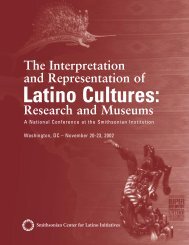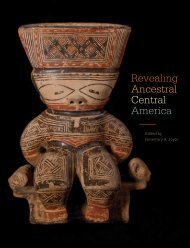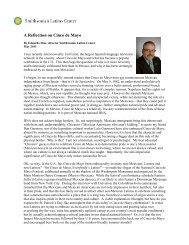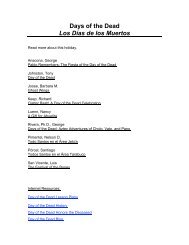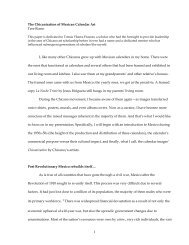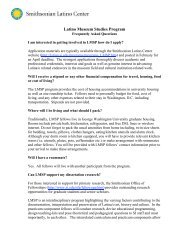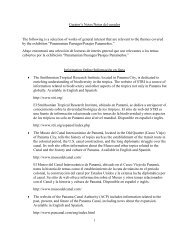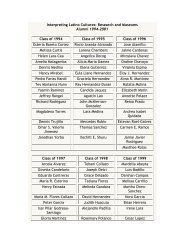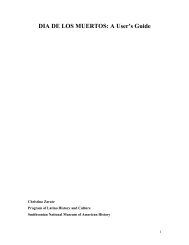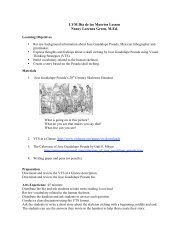(1861–1865) la Guerra Civil - Smithsonian Latino Center ...
(1861–1865) la Guerra Civil - Smithsonian Latino Center ...
(1861–1865) la Guerra Civil - Smithsonian Latino Center ...
You also want an ePaper? Increase the reach of your titles
YUMPU automatically turns print PDFs into web optimized ePapers that Google loves.
Roy Perez Benavidez<br />
Roy Benavidez was born on August 5, 1935, in Cuero, Texas,<br />
of mixed Mexican-American and Yaquí Indian heritage.<br />
Orphaned as a child, he began picking crops at a young age.<br />
He viewed the armed forces as a career opportunity and joined the<br />
Army in June of 1955 at the age of nineteen.<br />
Benavidez became a staff sergeant with the U.S. Army’s 5th Special<br />
Forces Group and was sent to Vietnam. On May 2, 1968, he volunteered<br />
to participate in a rescue mission near Loc Ninh in Cambodia, where a<br />
special reconnaissance team had been ambushed by the North Vietnamese.<br />
On <strong>la</strong>nding, Benavidez had to run to the team’s position while taking<br />
fire. As a result, he was injured in several p<strong>la</strong>ces, including his leg and<br />
head. In spite of his injuries, he continued coordinating the rescue effort<br />
and transporting the dead and wounded soldiers to a helicopter. The enemy<br />
fire intensified, injuring the pilot and causing the helicopter to crash.<br />
Benavidez struggled to rescue the soldiers in the helicopter, redirecting<br />
the “extraction” while protecting the wounded. As he loaded the soldiers<br />
onto a second helicopter he was clubbed in the head by the enemy soldier<br />
who he killed in one-on-one combat. During the mission, Sergeant<br />
Benavidez was able to recover c<strong>la</strong>ssified documents and save the lives of<br />
at least eight Special Forces soldiers.<br />
After recovering from his injuries, Benavidez continued to serve with<br />
the army’s elite Green Berets, reaching the rank of master sergeant.<br />
He died in El Campo, Texas, on November 29, 1998.<br />
Did you<br />
know?<br />
• Two years after his death, the<br />
U.S. Navy named a ship in honor<br />
of Master Sergeant Roy Benavidez.<br />
• Master Sergeant Benavidez<br />
was awarded the Distinguished<br />
Service Cross in 1968. He was<br />
nominated for the Medal of Honor, but<br />
could not receive it until a witness verified<br />
his heroic actions. President Ronald<br />
Reagan presented him with the medal on<br />
February 24, 1981.<br />
• Benavidez was injured by a <strong>la</strong>nd mine<br />
during his first tour of duty in Vietnam in<br />
1964, and he was told he might never<br />
walk again. After rehabilitation, Benavidez<br />
began serving as a Green Beret.<br />
• An elementary school in Houston, Texas,<br />
is named after the master sergeant.<br />
• For a brief time in 1983, Benavidez was<br />
taken off Social Security disability payments<br />
as part of a government cutback. Benavidez<br />
fought the decision, as he still suffered pain<br />
in his heart and leg due to his war wounds.<br />
In July 1983, his payments were reinstated.<br />
Roy Benavidez nació el 5 de agosto de 1935, en Cuero, Tejas, de<br />
legado mixto mexicano americano e indígena Yaquí. Tras quedar<br />
huérfano de niño, comenzó a pizcar cosechas a temprana<br />
edad. El veía a <strong>la</strong>s fuerzas armadas como una oportunidad profesional<br />
y se alistó en el Ejército en junio de 1955 a <strong>la</strong> edad de diecinueve años.<br />
Benavidez alcanzó el cargo de sargento de segunda c<strong>la</strong>se con el 5º Grupo<br />
de Fuerzas Especiales del Ejército de los Estados Unidos y fue enviado a<br />
Vietnam. El 2 de mayo de 1968, se ofreció para participar en una misión<br />
de rescate cerca de Loc Ninh en Camboya, donde un equipo especial de<br />
reconocimiento había sido emboscado por los norvietnamitas. Al aterrizar,<br />
Benavidez tuvo que correr hasta donde se encontraba el equipo mientras<br />
le disparaban. Como resultado, fue lesionado en varios lugares, incluyendo<br />
su pierna y cabeza. A pesar de sus lesiones, continuó coordinando <strong>la</strong>s<br />
<strong>la</strong>bores de rescate y transportando los soldados muertos y lesionados al<br />
helicóptero. El ataque enemigo se intensificó, lesionando al piloto y haciendo<br />
que el helicóptero se estrel<strong>la</strong>ra. Benavidez se esforzó por rescatar a los<br />
soldados del helicóptero, redirigiendo <strong>la</strong> “extracción” mientras protegía<br />
a los heridos. Mientras cargaba a los soldados en un segundo helicóptero,<br />
recibió un garrotazo en <strong>la</strong> cabeza y se vio obligado a pelear cuerpo a<br />
cuerpo con el enemigo, a quien mató. Durante <strong>la</strong> mission, el Sargento<br />
Benavidez pudo recuperar documentos c<strong>la</strong>sificados y salvar <strong>la</strong>s vidas de al<br />
menos ocho soldados de <strong>la</strong>s Fuerzas Especiales.<br />
Tras recuperarse de sus lesiones, continuó prestando servicio con <strong>la</strong> elite<br />
del ejército, los Boinas Verdes, alcanzando el cargo de sargento mayor.<br />
Murió en El Campo, Tejas, el 29 de noviembre de 1998.<br />
¿Sabía<br />
usted?<br />
• Que dos años después de<br />
su muerte, <strong>la</strong> Armada de los<br />
Estados Unidos nombró un<br />
barco en honor al Sargento<br />
Mayor Roy Benavidez.<br />
• Que el Sargento Mayor<br />
Benavidez fue condecorado con <strong>la</strong> Cruz<br />
de Servicio Distinguido en 1968. Fue<br />
nominado para <strong>la</strong> Medal<strong>la</strong> de Honor, pero<br />
no <strong>la</strong> recibió hasta que un testigo verifico<br />
sus acciones heroicas. El Presidente Ronald<br />
Reagan le presentó <strong>la</strong> medal<strong>la</strong> el 24 de<br />
febrero de 1981.<br />
• Que Benavidez fue lesionado con una<br />
mina terrestre durante su primer período de<br />
servicio en Vietnam en 1964, y le dijeron<br />
que era posible que no volviera a caminar.<br />
Tras su rehabilitación, Benavidez comenzó<br />
a servir como Boina Verde.<br />
• Que una escue<strong>la</strong> primaria en Houston,<br />
Tejas, fue nombrada por el sargento mayor.<br />
• Que durante un breve período en 1983,<br />
a Benavidez se le cortarón los pagos de<br />
Seguro Social por discapacidad como parte<br />
de una reducción gubernamental. Benavidez<br />
luchó contra <strong>la</strong> decisión, ya que continuaba<br />
sufriendo dolores de corazón y de pie<br />
debido a sus lesiones de guerra. En julio de<br />
1983, sus pagos fueron reinstaurados.<br />
49




